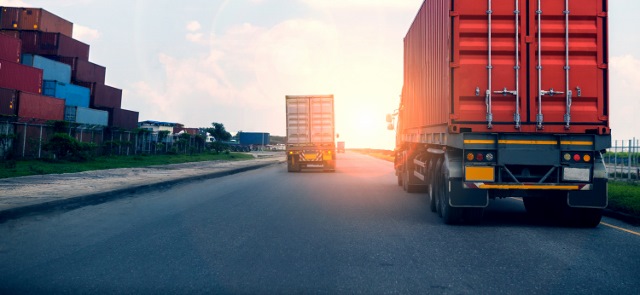Whatchallenges does freight transport face? As a fast-moving, ever-changing industry, freight transport is a sector that faces future challenges that constantly arise over time. In this regard, adapting to change is a key element in the survival of freight transport, and of the many European economies that depend on it.
What are the main challenges in freight transport?
The transition towards more sustainable freight mobility, unstable costs due to geopolitical reasons or driver shortages. What are the challenges for freight transport? In this post, we look at some of the challenges that are affecting the sector now and in the coming years.
The challenges of freight transport in 2024
The year 2024 has begun with the focus on some well-known challenges for the professional transport sector: new geopolitical conflicts are already disrupting world trade, with other local conflicts that require protocols to avoid past incidents, such as the agricultural sector protests in France, increased toll rates associated with the transition to ecomobility, and solutions to improve efficiency in route design with the arrival of duotrailers in 2024. We will now look at some of the challenges affecting freight transport over the coming months.
Geopolitical conflicts, a global challenge for freight transport
One of the main challenges for freight transport in 2024 will continue to be uncertainty about costs, especially those arising from geopolitical conflicts. On the one hand, the fuel used by road hauliers is no longer being subsidised as of 1 January this year. The government has not extended the aid of five cents per litre of diesel – which had previously been increased to 20 cents per litre – as it considers the economic situation generated by the war in Ukraine to now be normalised.
On the other hand, just as in 2023, the war in Ukraine and conflict in the Middle East has affected energy prices and thus the mobility of goods, with the focus in 2024 now on the Red Sea. The Israeli-Palestinian conflict has raised a new threat to world trade in the Suez Canal, a key arterial route for global transport: attacks on ships by armed groups such as Yemen’s Houthi rebels.
Since the attacks began in November, major shipping lines have been forced to reroute via South Africa, and is one of the biggest disruptions to global trade in the wake of the pandemic. The new routes significantly extend journeys between Asia and Europe, with a resulting increase in costs. An increase that has already had an impact on prices.
Attacks on Spanish lorries in France are also in the spotlight
And, in addition to global conflicts, there are local ones: another long-standing challenge for freight transport. For example, in 2023 there were a series of attacks on Spanish lorries at the border between the French towns of Le Boulou and El Pertús, following protests by French wine growers that forced the closure of the AP-7 between Figueres and France. Another risk of blockage at the Le Boulou toll was reported this January due to farmers’ protests, which is likely to continue to cause a stir in the coming months.
These acts of vandalism caused considerable damage and the European Commission has once again called for the necessary measures to be taken to prevent their recurrence. The CETM is asking transport companies and professional drivers involved in international transport to prepare alternative routes to avoid setbacks during the demonstrations.
The cost of sustainability: changes in toll rates in Europe
The transition towards more environmentally friendly freight mobility will be another of the challenges facing freight transport this year. In the race to define the energy of the future, to which we have been adding more sustainable alternatives such as LNG or HVO, there are also various measures aimed at bringing about change. These include tolls.
As we already explained in our post on changes to the German toll in 2023, an increase in the German toll rates (LKW-MAUT) has been applied since 1 December, significantly affecting drivers travelling through the country. In 2024, Austria has introduced new developments in this regard: on 1 January, it implemented significant changes to its toll rates, which now take into account factors such as distance travelled, axle configuration, Euro emission class and CO2 performance.
The measure concerns heavy lorries, buses and heavy motorhomes, i.e. vehicles with a maximum authorised mass of more than 3.5 tonnes travelling on motorways and dual carriageways. Here you can find the table of toll rates 2024 in Austria compiled by FROET.
Shortage of drivers and lower emissions: the arrival of duotrailers
The Directorate General of Traffic has legalised the circulation of duo-trailers on Spanish roads with two objectives:to reduce polluting emissions and to alleviate the serious shortage of drivers. These new large trucks consist of two trailers, can have a maximum length of 32 metres and can carry up to 72 tonnes of cargo. The regulations stipulate that they must travel on motorways, dual carriageways or multi-lane roads with separate carriageways for each direction of traffic.
This seems to be a measure that could help solve another challenge for freight transport in Europe, but it will require homogeneous regulation across the EU, so that the duo-trailer can cross borders in the rest of the continent. Another challenge we will be keeping a close eye on.

Frequently asked questions on the challenges of freight transport
How do changes in rules and regulations affect freight transport?
Changes in regulations can have an impact on aspects such as costs, driving times, emissions and safety requirements, requiring constant adaptation by the industry.
For example, the mandatory replacement of tachographs with an smart version for heavy goods vehicles will continue next year. In short, the new smart tachograph for heavy goods vehicles will record where the daily work starts, border crossings, loading and unloading, tracking of accumulated driving every three hours and where the daily work period ends. A change that is already leading to doubts and headaches, for example, companies and hauliers who purchased new trucks and buses in 2023 last year were unable to equip them with this control device due to lack of stock.
Being attentive to change is essential to prepare for new challenges and to respond to a changing industry.
What role does technology play in improving freight transport?
Just as we have talked about the new tachographs, we can also talk about how digitalisation is changing the professional transport sector. Technology plays a crucial role in route optimisation, real-time tracking, logistics management and improved visibility in the supply chain.
The implementation of new platforms for booking secure parking or to promote digital payment or new tools for greater control over refuelling, are today an added value that help optimise freight transport journeys.
How are environmental challenges in freight transport being addressed?
More sustainable solutions, notably the advent of renewable energies such as HVO or LNG, as well as other eco-friendly logistics practices, are being implemented to address environmental challenges.

